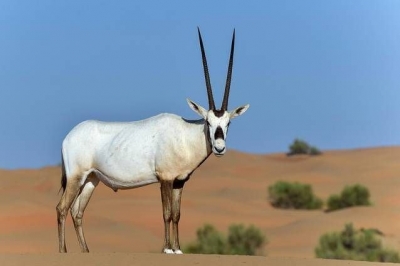
Located in a relatively remote corner of Oman, the Arabian Oryx Sanctuary once covered an area of about 27,500 sq.km. One of the largest and important wildlife reserves in the Middle East, it is known for a remarkably unique desert system. While the sanctuary is famous for its role in the Arabian oryx conservation story, it is equally infamous for having been the first UNESCO World Heritage Site to be delisted.
Following the Arabian oryx conservation efforts, UNESCO declared it a World Heritage Site of Outstanding Universal Value in 1994. However, in 2007, the property was delisted. “The World Heritage Committee deleted the property because of Oman’s decision to reduce the size of the protected area by 90 %, in contravention of the Operational Guidelines of’ UNESCO’s 1972 Convention. This was seen by the Committee as destroying the outstanding universal value of the site”. Oman reduced the size since oil was found in the region.
Flora and fauna
The sanctuary nurtures a diverse variety of plants, including many that are endemic to the region. In addition to the flora, the sanctuary also supports a wide variety of tenacious animals and birds, including its flagship species, the endangered houbara bustard (the sanctuary is its breeding site), Nubien ibex, Arabian wolves, honey badgers, and the largest population of Arabian sand gazelles.
Hope and opportunities
Oman had kept the sanctuary fenced off from the public for decades. However, towards the end of 2017, it opened up the sprawling space to visitors. It is believed that since its oil revenues were dipping, Oman turned to something else from the region that’s almost as precious – the Arabian oryx. The oryx numbers in the region are said to have been about 750 back then, offering Oman the promise of public interest in ecotourism. And not just that.
Conservation story
The sanctuary is also the place where an incredible conservation story originated. With hunting, the last Arabian oryx in Oman disappeared from the wild in 1972. As captive breeding sparked a ray of hope, as many as 10 of these animals were released into the Sanctuary in the 1980s. Over a period of time, the animal numbers grew. But then, when the area spanning the sanctuary shrank and poaching killed many animals, hope was lost. This was followed by the UNESCO delisting.
As mentioned earlier, the sanctuary also hosts a large number of Arabian gazelles (also known as sand gazelles) – the population stood at a comforting 850.
It is said that there are at least 12 species of trees that offer a natural habitat for a variety of birds. So while tourism efforts are welcome opportunities for both the sanctuary and its inhabitants, there’s the concern that it could also spell the return of poaching and hunting, which was the reason for the oryx going extinct in the first place.
Picture Credit : Google




